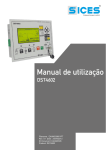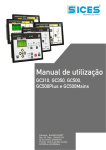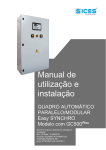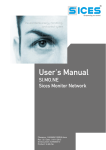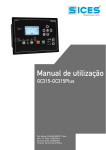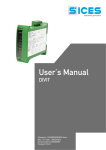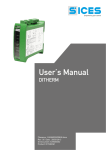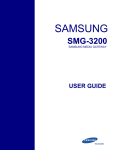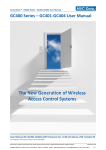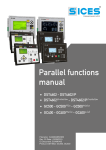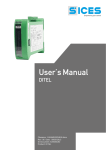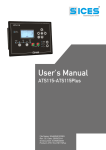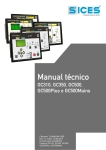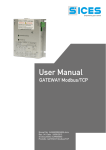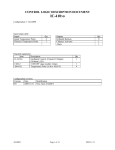Download 3. - SICES Brasil
Transcript
File name: EAAM03701EN Rev. 01 Date: 15/12/2014 ID Document: EAAM0371 Product: MC100 1. ................................................................................................................ 3 2. .................................................................................................................. 3 3. .................................................................................................................. 3 Buttons (ref. to fig. 1) ............................................................................................ 4 Indicators (ref. to fig. 1) ......................................................................................... 5 Multifunctional display........................................................................................... 7 Mode navigation (ref. to fig. 2) ........................................................................ 7 Display area layout (ref. to fig. 3) .................................................................... 9 Top status bar (ref. to fig. 4) ........................................................................... 9 Display mode ........................................................................................................ 9 Programming (P.xx) ....................................................................................... 9 3.4.1.1 Access codes ....................................................................................... 10 3.4.1.2 Parameters configuration ..................................................................... 10 3.4.1.3 Strings configuration ............................................................................. 11 3.4.1.4 Direct access to the latest page visited ................................................ 11 3.4.1.5 Protections and alarms parameters ...................................................... 11 Status information (S.xx) .............................................................................. 11 Electrical measurements (M.xx) ................................................................... 12 PMCBus (B.xx) ............................................................................................. 13 History logs (H.xx) ........................................................................................ 13 Manual commands ............................................................................................. 13 Manual synchronisation ................................................................................ 13 Manual power regulation .............................................................................. 14 Working sequence ........................................................................................ 15 Load control.................................................................................................. 15 4. ......................................................................................................... 15 Language selection............................................................................................. 15 ii MC100 User’s Manual NOTE: Please read this manual carefully before using the device. 1. This manual describes the MC100 controller. 2. ALARM – it is used to indicate a fault that make the genset operation impossible and causes the automatic and immediate turning off of the engine with emergency procedure. DEACTIVATION – it is used to indicate a fault that make the genset operation impossible and causes the automatic and immediate turning off of the engine with standard procedure (with cooling period). WARNING – it is used to indicate a fault that requires a manual operation but without the turning off of the engine. 3. KEY MC100 1 - Buttons 2 - Indicators Fig. 1 – MC100 Front view The commands are made of 11 buttons (1a, 1b, 1c). On the front view there are some indicators (2, 2a, 2b, 2c). MC100 User’s Manual 3 BUTTON FUNCTION OFF/RESET The group is disabled; warnings and stops are cancelled. It is possible to PROGRAM access to the parameters configuration. The controller sets the genset manual operation. Press the button START MODE UP Press the button STOP to start all gensets. to stop all gensets. MAN MCB button for the manual command in closing and opening operation of the MCB “Mains circuit Breaker”. Manual switch command in closing and opening operation with modes that depend on the SW and HW configuration of the plant. In case of voltage on BUS, the synchronization is required. MODE DOWN The controller sets the automatic management of the gensets starts. Press Ref. 1b the START button to activate/deactivate the TEST mode; the STOP button allows the stop of the gensets (with alarm activation). AUTO TEST The MCB allows the switch of the loads (only in TEST mode and depending on the plant type and configuration). The activation of an external input properly configured (or receiving of a correct command via SMS or serial port) may force the start of groups and load even with mains live or with inhibition input activated (REMOTE START). In program mode, it allows to cancel a variable value change, come back to the upper menu, and exit the programming. By pressing it for two seconds in any of the menu, it allows to exit the programming saving the position for a future return. EXIT/SHIFT In OFF/RESET mode, according to the page selected, by pressing it together with ENTER for at least 5 seconds, it can reset the counters, reload the default values for the programming parameters or cancel the history log (in the CANBUS version, it also allows to force the exit from BUS OFF mode). If used during the keyboard regulation functions, it aborts the function. Ref. 1a When the HELP information are available in the display pages, the HELP message will be displayed on the bottom bar, by pressing the button and hold. The multifunctional display buttons allow to select the previous or next page of display in all mode but PROGRAM. In the PROGRAM mode, they are used to place the cursor during the strings insertion phase. The horizontal buttons, combined with the button EXIT/SHIFT allow to regulate the contrast. LEFT/RIGHT To decrease the contrast press the buttons EXIT/SHIFT Ref. 1a (1a). To increase the contrast press the buttons EXIT/SHIFT (1a). 4 MC100 User’s Manual + LEFT + RIGHT BUTTON FUNCTION Up/Down buttons. They allow to select the modality of the multifunctional display. In PROGRAM and HISTORY LOG they allow to scroll the menus and the variables / registrations. During the setting, they allow to increase/decrease the variable value. UP/DOWN If used in combination with the EXIT/SHIFT button, they allow to scroll the menus by ten at a time or increase/decrease the variables by ten at a time. Ref. 1a ENTER/ACK Ref. 1a KM/KG GCB Ref. 1c It allows to activate the programming and enter a submenu, start a variable modification and confirm said operation. It also allows to activate the HISTORY LOG function and it permits to enter in the selected log and to “accept” any warning of fault on the non-volatile memory at the power-up. It acknowledges the presence of a fault and it deactivates the horn. GC310/GC350 manual or “TEST” is used to switch the load between the genset and the mains (the switch towards the mains is always possible, while towards the genset it is possible only if the related electrical measurements are in tolerance). GC500 controls the genset circuit breaker or the switch. Its function depends on the plant configuration. In case of working in parallel and at least one source that supplies the BUS, the pushbutton activates the unloading pad before the opening of the circuit breaker. If it required to open it without waiting for the pad, hold the pushbutton down for a few seconds until its opening. In MAN mode it can be used to control the start of the genset. In AUTO mode, it activates/deactivates the TEST mode. At the controller START power-up, if used together with STOP it allows to enter special functions. Ref. 1b STOP Ref. 1b It is used to control the engine stop. In AUTO, TEST or REMOTE START it activates a stop. If it is pressed in OFF/RESET mode, it carries out a LAMP TEST of all light indicators. At the controller power-up, if used together with START Led off Signalling it allows to enter special functions. Led steady on Led flashing Function It indicates that the operating mode is OFF/RESET Ref. 2b PROGRAM OFF/RESET MANUAL It indicates that the operating mode is PROGRAM The controller is in a different operating mode It indicates that the operating mode is MAN MC100 User’s Manual 5 Signalling Function The controller is in a different operating mode Ref. 2b It indicates that the operating mode is AUTO AUTO TEST Ref. 2b Flashing at 50% it indicates that the operating mode is TEST Flashing at 90% % it indicates that the operating mode is REMOTE START. The controller is in a different operating mode The display is in “STATUS” mode. Ref. 2b STATUS The display is in “PROGRAM” or another mode. The display is in “MEASURES”. Ref. 2b MEASURES The display is in “PROGRAM” or another mode. The display is in “EVENTS” mode. Ref. 2b Ref. 2 EVENTS ALARM WARNING The display is in “PROGRAM” or another mode. It indicates the presence of at least a alarm, a deactivation or an unload. It indicates the presence of at least a warning that has not been acknowledged by the pushbutton “ACK/ENTER” yet. There are no alarms or warnings It indicates the activation of at least one of the two serial ports. It indicates the activation of the serial port TEST mode. AUX. LINK Ref. 2 It indicates the activation of a serial port command (the second serial port is managed by the signalling only if configured as communication port and not as I/O). It indicates the deactivation of at least one of the two serial ports. PMCBUS Ref. 2c It indicates that the interface PMCBUS is on, working and in ERROR-ACTIVE mode. Flashing at 25% it indicates a communication fault: the port is in ERROR-PASSIVE mode. Flashing at 75% it indicates a communication fault: the port is in BUS-OFF mode. CAN-BUS is disabled. MAINS LIVE Ref. 2c Mains voltages and frequencies are on and steady in tolerance, or that the digital input function “40-External Mains Sensor” is on. Mains voltages and frequencies are off, or that the digital input function “40-External Mains Sensor” is off. Flashing at 50% between the two previous statuses. Flashing at 25% mains voltages and frequencies are on but not tolerance. Mains voltages anomaly or wrong rotation cycle. Flashing at 75% mains voltages and frequencies are on but over the tolerance. Voltage on on the genset bar. 6 MC100 User’s Manual Signalling GENERATOR BUS LIVE Function Voltage off on the genset bar. Ref. 2c MCB open. MCB not configured or off. MCB closed. MCB Flashing at 25% MCB open at closing command. Flashing at 75% MCB closed at opening command. Ref. 2c Flashing at 50% in case of synchronization with led BUS LIVE. Voltage on on the LOAD BUS. Voltage off on the LOAD BUS. BUSLIVE Flashing at 50% in case of synchronization on MCB or MGCB. Alternate flashing on MCB or MGCB. Ref. 2c MGCB open. MGCB closed. MGCB not configured or off. Flashing at 25% MGCB open at closing command. MGCB Ref. 2c Flashing at 75% MGCB closed at opening command Flashing at 50% in case of synchronization with led BUS LIVE. The backlit light is managed by the controller, which provide to turn it off if no buttons are pressed in configurable time (P.4502). In order to turn it on, just press any of the buttons. It is possible to deactivate the automatic power-off bringing the parameter P.4502 to 0. The contrast is configurable by pressing EXIT/SHIFT EXIT/SHIFT + RIGHT + LEFT Ref. 1a to decrease it or Ref. 1a to increase it. The display has different visualization modes composed by different pages. MC100 User’s Manual 7 Mode Page Programming P.XX Status information S.XX Electrical measures M.XX PMCBus B.XX History Log H.XX Generally, surfing among modes is possible by means of the buttons UP Ref. 1a and DOWN Ref. 1a. Fig. 2 – Surfing among modes In order to visualize the pages in the mode, use the button LEFT RIGHT Ref. 1a and Ref. 1a. In some modes (e.g.: mode P.xx and mode H.xx), it is necessary to press ENTER Ref. 1a and DOWN Note: In case the UP required to press ENTER 8 MC100 User’s Manual , and then UP Ref. 1a to surf among pages. and DOWN buttons are used to manage the mode functions, it is to activate these functions and EXIT/SHIFT to deactivate it. KEY: 1 – Status bar 2 – Data area B.03 TOT. PMCB 1 kWh : kvarh: kW : kvar : MDPt (kW): DPRt (%) : 2 18:23 230000 172500 1235.8 930.6 1500.0 82.3 Fig. 3 – Display areas The upper status bar contains surfing, time and/or status information. KEY: 1a – Mode 1b – Page 1c – Page title 1d – Hour 2 – System status 2 B.03 TOT. PMCB 1a 18:23 1c 1d 1b Fig. 4 – Top status bar display The present mode is indicated by the proper space on the top status bar (1a). The mode (1a), together with the page (1b), allow to individuate and refer to a page unequivocally. The system status (2) displays part of the information of the page S.01 (status info) which is useful for the operator, because it can be displayed even if it is accessing other pages of display modes. In some pages, pressing EXIT/SHIFT , the top status bar is replaced, for the time in which it is pressed, by a System Status message. If the message is not available, the status bar is not displayed until the button is released. WARNING: a wrong programming of one or more parameters can cause malfunctioning or damages to things and/or people. The parameters changes must be carried out only by skilled personal. The parameters can be protected by password (see par. Access code). MC100 User’s Manual 9 This mode allows to display and change the programming parameters. Each parameter is associated to a numeric code made of 4 digits (e.g. P.1101), which identifies the variables independently by the language used. The first line under the top status bar allows to identify the present menu by means of the identification number of the menu and by the associated text. In this line it is displayed a couple of numbers on the right. The first indicates which entry of the menu is selected or which page is displayed, the second indicates how many entries or pages can be displayed in the present menu/submenu. The programming access can be conditioned by 4 different levels of PASSWORD listed in a priority order. 1. SICES Password 2. Manufacturer Password 3. Installer Password 4. User Password Warning: In case of loss, it is possible to reconfigure the password by accessing with an higher-level password. In case of loss of the “MANUFACTURER” password, turn to the support service. The first page (0000-Access Code) of the menu SYSTEM requires the configuration of the access code if one or more passwords have been assigned. No password is assigned if equal to 0. As USER, it is possible to display and change the User password only. As INSTALLER, it is possible to display and change the User and the Installer password. As MANUFACTURER, it is possible to display and change all three passwords. As SICES, it is possible to display and change some parameters of plant configuration, related to the parallel functions. Warning: The critical parameters cannot be changed by the User. The pages related to the Password configuration are displayed in the menu SYSTEM if in possession of the change rights. If once inserted the password in the programming, the Password configuration is not displayed, press EXIT/SHIFT to go back to the previous menu and access again. The access code configured is valid for a period of about 10 minutes since the end of programming. After this period of time, the access code has be set again in order to access the programming again. Activate the mode by pressing ACK/ENTER Use the scrolling buttons UP . Ref. 1a and DOWN Ref. 1a to select a menu and ACK/ENTER to access. Select the variable or the submenu with the scrolling buttons UP Ref. 1a and DOWN Ref. 1a. Pressing ACK/ENTER , if there are no submenus, they are displayed the pages of the variables of that menu entry. The value of the variable is displayed in square brackets, for example: [400]. 10 MC100 User’s Manual Press ACK/ENTER to change the variable; the square brackets [ ] will flash. Use the vertical scrolling buttons UP ACK/ENTER Ref. 1a and DOWN to confirm or EXIT/SHIFT Ref. 1a to change the value and press to cancel. In order to change the variables, the operating mode must be “OFF/RESET”. Some variables can be changed also with operating mode different from “OFF/RESET”. If it couldn’t be possible to change a variable, it would be represented in the following way: <4100>, indicating that it is not possible to change the parameter. Press EXIT/SHIFT to exit the programming menu. Some parameters require the configuration or the change of strings. In this case, by pressing ACK/ENTER the square brackets [ ] which include the variable will flash and it will be activate a cursor under the first character of the string. With the scrolling buttons LEFT and RIGHT , it is possible to select the character to change. Then, using the scrolling UP Ref. 1a and DOWN Ref. 1a it is possible to change the character selected. The operation has to be repeated for all the characters that have to be changed. By pressing ACK/ENTER (confirm) or EXIT/SHIFT (discard) the procedure is concluded. It is possible to access directly to the last page displayed in the programming. This can happen if, when exiting the programming, the button EXIT/SHIFT to the main menu. is hold down for 2 seconds instead of going back The same result is obtained by entering the programming after that the controller has automatically exit the programming. This can happen if no operation is done for 60 seconds or if the operating mode is changed in MAN or AUTO. The protections and the alarms are generally configurable by means of proper variables. It is also configurable the time of intervention associated to the protection. If the time of the intervention is equal to 0, the protection is disabled. In this mode, the information on the system status are supplied. It is possible to scroll the different pages by means of the horizontal scrolling buttons LEFT and RIGHT . Page S.01 displays system status information. Part of these information are displayed on the upper status bar. Page S.02 is automatically displayed in case of fault. Each fault is displayed by an initial letter that define the type of alarm: "A” : Alarm MC100 User’s Manual 11 “D” : Deactivation “U” : Unload “W” : Warning The letter is followed by a numeric three digits code that identifies that fault. The alarm code which has not been acknowledged by the ACK/ENTER reverse. button yet, will flash in Page S.03 displays the generic status acquired by the plant through the digital inputs of the controller. Page S.04 displays the serial communication status. In case of operating problems, check the information on this page. In case of use of a GSM modem, the telephone operator and the radio signal are displayed too. Page S.05 displays the PMCBus communication status. Communication status of the bus. There are three possible signalization: - ERROR-ACTIVE: normal operation - ERROR-PASSIVE: there are faults, but the communication is still working. - BUS-OFF: the controller disconnected because of too many faults. The communication faults counters are indicated. If the cause of the malfunctioning has been removed, it is possible to force the BUS-OFF exit by holding the buttons ACK/ENTER down for five seconds. + EXIT/SHIFT Page S.06 displays specific controller information: date/hour, internal temperature, voltage, serial number (ID CODE), internal code and firmware revision. Page S.07 displays the digital inputs status acquired by the controller. “0” indicates input not active. "1” indicates input active. Page S.08 displays the digital outputs status acquired by the controller. “0” indicates input not active. "1” indicates input active. Page S.09 displays the measures acquired by the analogue inputs of the controller. It is possible to scroll the different pages by means of horizontal scrolling buttons LEFT and RIGHT . In this mode the measurements acquired by the controller on the mains are fully displayed. Page M.01 displays the single-line diagram of the plant and measures of active power and power factor. Page M.02 displays the main electrical measures (Voltages, Frequency and Rotation cycle) of the Mains. Page M.03 displays the main electrical measures (Voltages, Frequency and Rotation cycle) of the Genset. Page M.04 displays the phase currents of the Genset/Load/Mains and the auxiliary current. Page M.05 displays the active power, the power factors and the type of load, phase and total. Page M.06 displays the reactive and apparent power, phase and total. 12 MC100 User’s Manual Page B.01 (available only if the controller is configured for the Parallel/Mains management) displays the codes of the mains protections during the parallel phase. The protection codes are stored, with reverse flashing, until they are acknowledged by the button ACK/ENTER . In this page it is possible to change the power supplied in the application of parallel with the mains BASE LOAD and IMPORT/EXPORT Page B.02 displays the synchronizing information. By the use of the synchroscope and in MAN mode, it is possible to carry out the manual synchronization (see par. 3.5.1). Page B.03 displays the information related to the gensets connected to the PMC-Bus (Active and Reactive energy, Active, Reactive and Nominal power and Load percentage). Page B.04 displays the information related to the controllers connected to the PMC-Bus. Page B.05 (B.06, B.07, B.08 available only if 6 or multiple of 6 gensets have been activated) display the information related to each genset connected to the PMC-Bus (PMC-Bus genset address, active and reactive power). In AUTO mode, it is possible to manually manage the operating sequence of gensets (see par. 3.5.3). Pages B.09 and B.10 display the information related to the load. The first page displays the operating status, the genset rotation cycle, the master genset identification and the priority list. It is possible to manually select the master genset (see par. 3.5.4). The second page displays the required power, the activation threshold, the deactivation, the power percentage and the function status. Page B.11 (available only if the function has been configured) displays the information related to the management of the load to activate/deactivate the loads (active outputs, function status and the power percentage (also in reverse). For the function configuration, refer to document EAAM0360XX (Parameters table). In this mode it is possible to access the visualization of the events and data. Every record is identified by number, date and hour. The number is displayed in the first line of the multifunctional display together with the total number of records. Considering that the log, once reached the maximum capacity, overwrites the oldest record, the identification number can change in time. In order to activate the mode, press the button ACK/ENTER of the desired function. . A menu will guide to the selection WARNING: Before proceeding with the manual synchronisation, check that the configuration impedes the closing of the circuit breaker in case the adjustment of speed and phase is not correct. MC100 User’s Manual 13 By selecting the mode MAN with the pushbuttons UP Ref. 1b and DOWN Ref. 1b it is possible, depending on the type of plant, to control the closing of MCB by means of the manual synchronisation. In MAN mode with gensets started with START , genset and mains/bar voltage live (led MAINS LIVE on, led BUS LIVE steady on and led MGCB steady on), the function is activated by pressing the pushbutton related to the open circuit breaker MCB . Pressing the button, the circuit breaker is commanded to close, but the function of manual SYNCHRO is activated and the synchronisation page B.02 is automatically displayed. In order to adjust the engines speed and/or the voltage manually, press the button ACK/ENTER and the buttons LEFT and RIGHT to select between speed or voltage adjustment; use the buttons UP Ref. 1a and DOWN Ref. 1a to change the value in percentage (%). When the synchronoscope indicates that it is possible to command the closing, press the circuit breaker button MCB again and hold it down till its closing. In any moment, by pressing EXIT/SHIFT possible to change screen. the speed manual commands are deactivated and it is By changing the screen, all the manual synchronisation procedure is cancelled. Note: The function described is available only if it has not been set the use of an external potentiometer for the speed control; in this case, the speed change will be carried out by means of the potentiometer. Ensure that, after the circuit breaker closing, the speed demanded is the most closed to the nominal one in order to allow the controller to adjust the power properly. Warning: Considering that there may be set low power ramps, check the command with the value of “Power required” displayed on the same screen and not with the value of power actually provided. In applications of parallel with the mains with the function BASE LOAD or IMPORT/EXPORT, it is possible to manually adjust the power to be provided without changing directly the parameter that defines the adjustment power. Visualize the screen M.01 and press ACK/ENTER Ref. 1a or "cosfi required"; use the button UP Ref. 1a to increase the value and DOWN Ref. 1a to decrease the value, which is set in percentage (%). The value that will be changed is highlighted in negative. Press ACK/ENTER to exit the adjustment procedure. Note: The function described is available only if it has not been set the use of an external potentiometer for the speed control. 14 MC100 User’s Manual It is possible, through the screens B.05, B.06, B.07 and B.08, to manage the operation of each genset and to change the kind of operation among: AUTO Mode The controller starts/stops the genset in relation to the load required. Mode ON The genset is always on. Mode OFF The genset is always off. Press ACK/ENTER and use the vertical scrolling buttons UP 1a to select the genset interested. Press the buttons LEFT press ACK/ENTER and RIGHT Ref. 1a and DOWN Ref. to select the genset operating sequence required and again to exit this mode. The load control function manages the start/stop of the gensets based on the power required and/or set. In detail, this function allows to: In parallel with the mains it allows to start/stop the gensets necessary for the supply of the energy required. In parallel in stand-by mains it allows to start/stop the gensets necessary for take of the load connected Guarantee a time rotation cycle of all gensets activated. This function is enabled only in the modes AUTO and REMOTE START. 4. The controller has the possibility to display text messages in different languages. In order to select a different language from the one set, visualize the screen S.06 (CONTROLLER). To change the LANGUAGE press ACK/ENTER scrolling buttons UP ACK/ENTER and DOWN to confirm or EXIT/SHIFT ; the square brackets [ ] will flash. Use the vertical to display the LANGUAGE available and press to cancel. MC100 User’s Manual 15 This document is owned by SICES s.r.l.. All rights reserved. SICES s.r.l. reserves the right to modify this document without prior notice. SICES has made any effort to ensure that the information herein provide are correct; in any case SICES does not assume any liability for the use these information. The disclosure by any means of this document to third parties is not allowed. SSSTTTTTGHTY 1
















